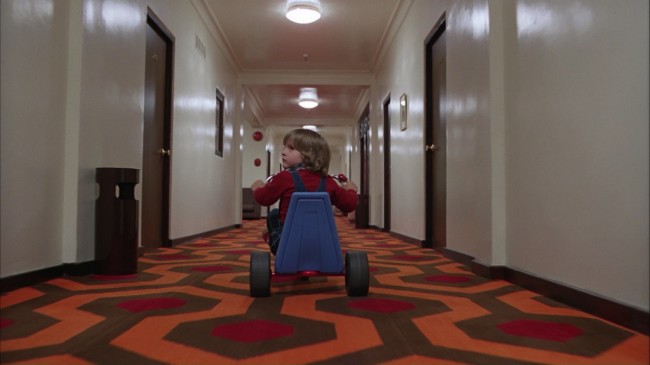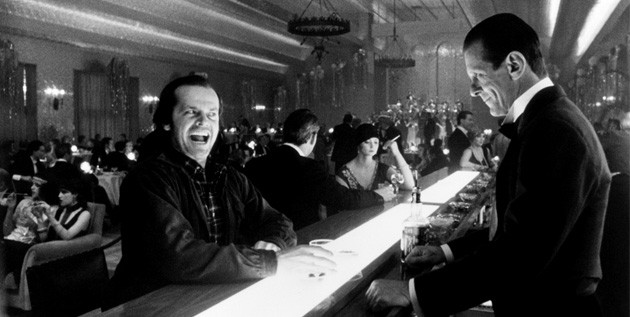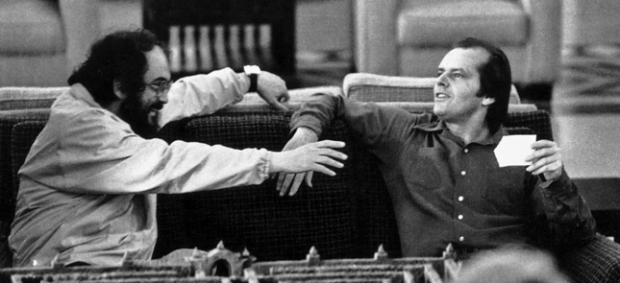
At this year’s Sundance film festival there was one film that stuck out as anomaly of a new kind of documentary that re-examines the very essence of film critique. Rodney Ascher’s Room 237 is a study of Stanley Kubrick’s much beloved horror film The Shining, dissected by a series of obsessive fans of the film who have seemingly uncovered a laundry list of potential revelatory theories that put the film in a new light. Room 237 is playing in the Directors Fortnight here in Cannes, and I was fortunate enough to sit down one-on-one with the film’s director Rodney Ascher and producer Tim Kirk as they discuss new theories they’ve heard since premiering the film, other fascinating stories about other Kubrick films and how the film has slightly changed since premiering at Sundance.
The Film Stage: How did you guys first become aware of the Kubrick conspiracies and what prompted you to want to make this film?
Rodney Ascher: Well, I wouldn’t call them all conspiracies. A lot are just theories and analyses. You know, I’ve certainly been a lifelong Stanley Kubrick fan ever since I had to run out of The Shining ten minutes after it started when I was a little kid. But I think we got on this track maybe two some years ago. Tim posted an article about a new The Shining analysis on my Facebook page, and it was kind of mind-blowing, and then we just wanted to sort of run the gamut and find out what the rest of them were. I had recently done a short with a similar technique and was thinking about a more elaborate follow-up. Once we saw how much stuff was out there and how many things people were saying about this movie, and how more and more was coming out all the time, it seemed like pretty fertile territory. There is a secret origin for the movie. Years ago I had done a series of slides that were sort of a parody of the trivia slides that played before the movies in multiplexes that we showed at CineVegas, and one of them was a deep look at the numerology of the number 237. But you know, it had a little FYI and a mortar hat on top of the F, put into this goofy context as if…like back then, the idea that this kind of thinking would be of interest to the general filmmaking community seemed like a hilarious joke. But here we are.

And did you post that short online? Is that something we can find online?
RA: Oh yeah, just go to thesfromhell.com.
And you guys had a blog or a website. Was that part of how some of these theories started to come together?
Tim Kirk: No, not really. It was really just about each of us exploring and then, “Oh, look what I found!” We both have young children, and we take our kids to the park and talk about the minutiae for the latest theory that we had found. But yeah, just sort of ping-ponging all over the internet.
And that’s how you met a lot of the subjects that you guys interviewed?
RA: A lot of them, although two of them came, like, you know…Bill Blakemore is an ABC journalist and what he wrote about the American Indian, it was in syndicated newspapers across the country. We’ve read about it online, but that’s where that’s where that first appeared, and Geoffrey Cocks has been quoted online, but he wrote his theories. It’s a book called The Wolf at the Door. It’s a book examination of Holocaust and World War II allegories within all of Kubrick’s films, so the fifteen-ish minutes he might appear in the movie is just the smallest amount of things that he’s had to say.
TK: A very academic study. It’s very good.
RA: The website, the blog, and the Facebook thing where we post just any interesting Kubrick stuff, that all happened after the film was finished. A lot of it is stuff that could very well have gotten into the film, but, you know, the glue has hardened at this point.
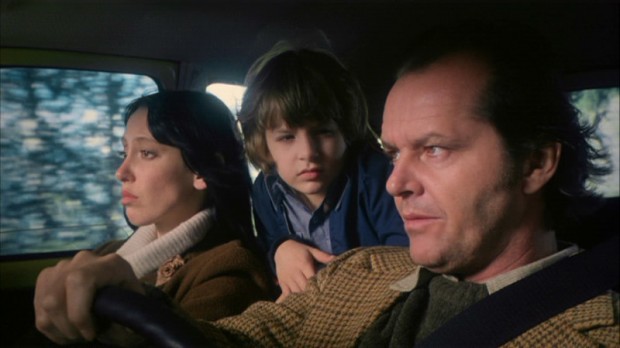
Do you guys personally believe all the theories? Are you skeptical of some? Are you fans of some of the others? Or are you kind of just open to all of them?
TK: I think all of them resonate for me, at least, in some way or another. I find myself returning to Juli Kearns examination of the impossible landscape of the hotel again and again. That kind of resonates for me as, like, the nightmare dreamscape I find that film to be.
RA: Yeah, kind of the fun of it is being able to see the movie through their eyes. You know, when they describe their process of discovery, I’m right along there with them. And it’s weird. Like, when I watch The Shining now, it’s almost as if you’re watching a DVD with multiple audio tracks, but in my head, I can switch to watching this through Jay’s eyes, or let’s see how John Fell Ryan sees this scene, or the handful of times that I see things my own way, or through one of the people that we weren’t able to talk to or get into the film.
Was it a conscious decision for you guys not to do any on-camera interviews?
RA: Yes, yes, yes, yes, yes.
Can you talk a little about that?
Rodney: Well, there’s a couple of things. In the short, logistically, it didn’t make sense for me to travel to meet these people, and I found something really interesting about having to struggle a little bit to find imagery that would always describe what these people are saying, sometimes literally, sometimes more subjectively, sometimes imagery that just sort of describes their state of mind. So we wanted to take that further in this film, and we just didn’t have the video. I interviewed folks over the phone and I mailed them digital audio recorders that they mailed back and then I’d get the card out. So not showing their faces was always important in the beginning, only because I kind of hate traditional talking headshots in documentaries that are just so mundane. And usually they’re just not shot very well, or if you shoot them well, then they’re kind of fake. It’s like, what, did you bring this guy into the studio and you dressed him? You know, there’s no way to win that game. So since this movie is much about ideas, a lot of these ideas are metaphysical and big. You don’t want to be grounded to the mundane reality of here’s this guy’s office, this is her living room, but to use imagery that would express this point of view and keep it in idea space. So maybe if you’ve lost faith in one person or they look untrustworthy. You know, if you don’t like people over fifty, or you think this guy’s whatever, you don’t bring that baggage to it.
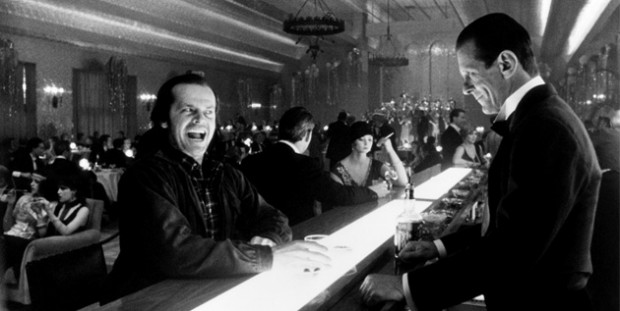
One of the things I really love about the film is the way that you intertwine all the clips from Kubrick’s films in addition to other films, but one of my biggest questions was, after seeing it initially, have you guys had any issues with copyright holders, or is this is big case of fair use in terms of how you’re using all this footage?
TK: Well, you know, any documentary, you have to go through clearance and you have to license some film clips and work out deals with others and use fair use with others. This is probably a bit more complicated than most of the documentaries that we worked on. But we worked with a great team of lawyers. There was a vetting process. We finished that, and I think that in the long run, there’s that saying about limitations can sort of lead to creativity, and I think that some of the stuff that we butted heads about, that really inspired Rodney to make some really interesting aesthetic choices. I don’t think we’ve had to compromise in any way, which I find really gratifying.
Have any people from the Kubrick estate contacted you, or have they seen the film? Do you guys know if they’ve seen it?
RA: I don’t think so. We’ve been totally independent from them from the beginning. I think this is always about what happens to this film when it hits the minds of the audience, when it leaves the theater, when it leaves the set, when it leaves the laboratory. So we never wanted to talk to anybody directly involved in the making of the film. It would be amazing to talk to some of those folks now and hear what they think about it.
Have you guys heard any great new theories since screening the film? Have people come up to you and been like, “Well I have this great theory that you guys didn’t even touch on,” and maybe you’re getting a lot filtered through the website?
RA: An interesting thing about this phenomenon is you’d think that a movie that came out 30 some years ago, that the amount of writing about it would decrease as time goes by. There’s been a couple peaks and valleys, and now it seems to be increasing exponentially.
TK: Since we started researching this, so many new things have come out and people have new ideas.
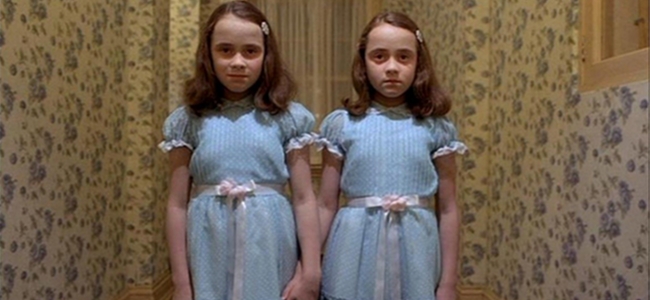
Do you have any examples? I’d love to hear one or two.
RA: Well, there’s stuff that came out either before the film or in the course of the film that we weren’t able to get in. There’s a British guy, Rob Ager, who’s written extensively about The Shining, and he’s seen the figure of a body drowned in the blood that’s come out of the elevator, and he thinks that it’s Tony because this is the moment after which you never hear Tony spoken about or speaking again. So Danny’s been abandoned, and he has to use his own resources after that. He’s also done a really intricate examination of the maze, he has something to say about the Gold Standard in the United States, and it goes on and on and on and on, but he’s making his own DVD about his stuff. So I had an interesting correspondence with him, but he decided not to be a part of the film and is the mastermind who we allude to a little bit, because he inspired John Fell Ryan’s forward backwards thing. His writing about it is incredibly intense. He talks about Marshall McLuhan and he talks about dates and portals, he’s interested in video game theory and how this works like a video game engine.
TK: Isn’t there some temple…
RA: He gets into some Mayan history.
TK: But as we were doing sort of the final cut of this, this guy discovers he hears the word “shone” at seventeen points in the film, and he thinks it’s Kubrick in post saying “shone” and searches where these are in the character arc of Jack in the film. And then independently of him, one of our interviewees, Juli, had discovered this sound and not heard of this guy, independently had come to it. So we’ve talked about the idea of…
RA: Well, it’s like quantum physics that as people observe the movie, it starts to change. John Fell Ryan talks a little bit about it at the end of the movie, and this instance is like, “Nobody has ever noticed this for thirty-two years, then one guy notices it and someone else notices it a couple months later.” This sort of intense focused viewing has introduced an anomaly into the film and now everybody can see it.
You touch about it a little bit in the film about some of the other theories that people had about 2001, for example. Do you think there’s the potential to do another style of film like this about another one of his films? Or do think it was specifically like The Shining was kind of this culmination of Kubrick at a certain point of his career where he was playing with a lot of these elements?
RA: Well, there’s some that say that Eyes Wide Shut is even denser, and there’s a body of work coming out about that. I know personally, I’m not interested in doing another film like this about another Kubrick movie, though if someone else would make it I would love to see it. I think we were talking to someone else and came up with an idea that was only half-way facetious, that if there were to be a follow-up, I wouldn’t want to broaden the focus but to narrow it and make the entire movie just about the last shot. Getting into this, people thought that exploring the hidden meanings of The Shining would be too narrow a focus for an entire feature, but we found out that this could have been three times as long. It would be fun to narrow the focus even further.
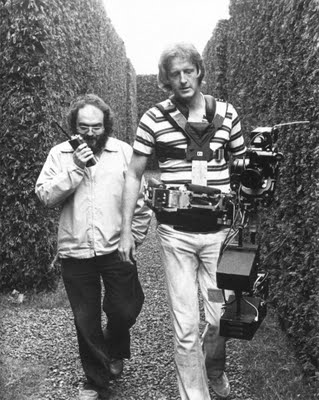 It’s interesting, as a film critic watching this movie, it makes you think about thinking about film critically in a completely kind of different way. It kind of almost reexamines the whole idea of film criticism. Can you talk a little about that? Was that an intention starting, or is that something that when you saw the end product…
It’s interesting, as a film critic watching this movie, it makes you think about thinking about film critically in a completely kind of different way. It kind of almost reexamines the whole idea of film criticism. Can you talk a little about that? Was that an intention starting, or is that something that when you saw the end product…
RA: Well, I love that, because it isn’t anything I really thought of, but there seems to be a phenomenon with Kubrick that a lot of people see Kubrick as a version of themselves, but even deeper. I know I’ve been teaching an editing class and thinking a lot about film editing and the meaning of different types of cuts, so I’ve been mostly focusing on the way he edits. In particular, the scene in 2001 where the caveman gets the idea about using the club. Then we flash forward to the beasts falling, and it’s like, is that a flash forward? Is that his imagination? Is that the idea being implanted into him? What’s the meaning of that cut? Our composer said, “Well, I see Kubrick as the world’s greatest music supervisor.” And I see him through that window, and he does make incredibly bold choices of music. Once he uses a piece of music in his score, “Thus Spake Zarathustra” is now known as the theme from 2001: A Space Odyssey. And even the ironic way he uses “The Rite of Spring” at the beginning of Dr. Strangelove is incredibly smart and incredibly meaningful. So I think there’s been at least another critic who’s said, “This makes me think about film criticism.” And I love that, but I think you’re having a phenomenon that was similar to mine.
That’s true. After I saw it in Sundance, a bunch of friends and I, we just couldn’t stop talking about how that has changed almost our perspectives on what film criticism is. So now that you’ve had this success with the film, IFC’s picked it up, do you have any plans for another project in the pipeline? Maybe a narrative or documentary? Or are you still just kind of riding the wave of this thing?
RA: I’d love to do a narrative film, but certainly one that would be messed up in my own particular way. But I have to take this further. And we don’t have the projects in process yet, and it’s only sort of the vaguest ideas of what territory we’d approach, but it would be something along the same lines, but Toronto. Further. It wouldn’t be a documentary about the dangers of nuclear power, as important as that is. Somebody else asked about a conventional documentary like the JFK conspiracy and the JFK assassination, and that’s not necessarily a topic that I’d be interested in, but the Zapruder film, in particular, could be. I don’t think I’m going to do the Zapruder film, but that’s where I would go if I was doing…
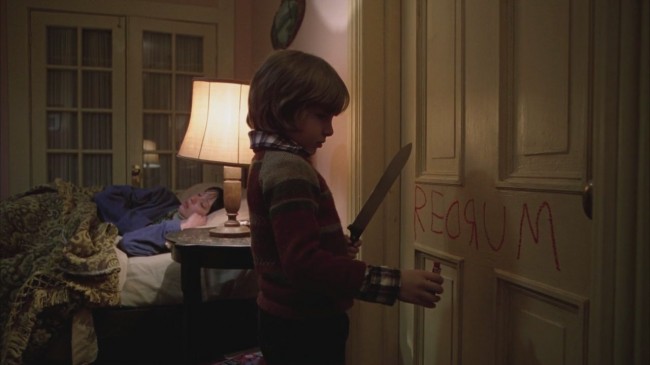
And then you were mentioning earlier that the cut here is slightly different. Could you talk about some of the changes that you made to the film, or additional material, or did you cut some stuff out?
RA: I think there’s thirty seconds cut out because I thought we got a little off topic, but a lot of it suggests moving the things out. It did introduce a couple of new shots. It seemed to be kind of meaningful in an interesting way. And then, there’s just little technical things, like we used to zoom in to characters who were frozen as freeze frames, but now, I’ve given them a little bit of life, so they look kind of like those animated GIFs where people are in a loop. And, probably the only reason I stopped was we had to get the print burned for the festival.
TK: It’s subtle, but I’ve seen the film so many times, and just sitting in the screening room the other day doing quality control, I saw a new thing and I was just like, “oh man! So cool.”
Now I’m dying to see it.
RA: It’s kind of the curse of being your own editor and working in your own studio, like a friend of mine had a film at Sundance, and there’s a lot of things he wants to change, but he’s not the editor to require getting through in time and getting studio time, and there’s not a budget for time or money to do that, but because I just had to stroll into the other room in my house, there’s nothing to stop me. There’s nothing to end my OCD.
Do you think that some of this additional material, looking ahead, might end up on a Blu-Ray release or something on the website or maybe even user-submitted theories that you guys have been viewing?
RA: I would love for it to, and I think there’s only like one major sequence that we cut out of the rough cut for the Sundance one. The problem with it is, and it was kind of amazing, John Fell Ryan was tracing the paths the characters were walking through the hotel, and he’s blogged about this. His blog is amazing. It communicates well. We’ve got five percent of it in our movie, but he sees the paths the characters take more than once describes the Big Dipper, and that the Big Dipper has implications for the movie because it’s known by other names, like the Drinking Gourd, which there’s liquids in the movie, Jack is an alcoholic, and blood comes out of the water, and the Drinking Gourd was the name that escaped slaves called the Big Dipper when they were on the Underground Railroad. And, there’s the oppressed peoples kind of something, and it goes on, and on, and on. But, the problem with that scene when you put it on the DVD is the audio is pretty complete, but the video is half-assed, so I could spend two months finishing that scene as an extra, and I might, but we’ll see when things have to go to press.
TK: But, we would love to have a webpage that sort of became a clearing house for all the theories out there and the idea of user-generated video or analysis. It would just be…
Or a hash-tag that you use for the videos.
RA: It would be great!
